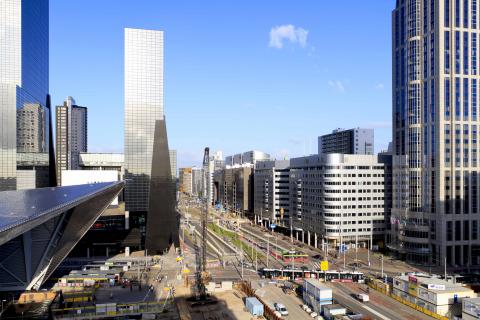Rotterdam – Creating an Office of Resilience

City skyline and construction of Rotterdam Central Station, an important transport hub with 110,000 passengers per day on Sept 5, 2012 in Rotterdam, Netherlands. © Shutterstock
Rotterdam, Netherlands is a City located in Southern Holland. The municipal population of 620,000 is split into 14 boroughs, governed centrally by a city council, currently headed by Mayor Ahmed Aboutaleb.Rotterdam has achieved a high level of success in developing best-in-class climate adaptation and water management strategies to address the threats of sea-level rise and pluvial flooding inherent in their unique geography and morphology. The City is currently striving to link these achievements with strategies for addressing other risks and in particular emerging social cohesion challenges. The range of shocks and stresses Rotterdam faces include: heat waves, aging infrastructure, fossil fuel dependence (Rotterdam is home to the largest port in Europe), unemployment and shifting demographic & macroeconomic trends, lack of community preparedness, weak citizen engagement and cohesion, and exposure to cyber/ICT disturbances or failures.
“Cities could lead us towards new solutions, because cities are capable of connecting people.”
- Ahmed Aboutaleb, Mayor of Rotterdam
Priority Areas for Intervention
Addressing these shocks and stresses with innovative and integrated solutions required a new direction and vision for resilience that would build off of the City’s recognized leadership in water and climate risk resilience. The City wished to assess the gaps and opportunities in preparing for relevant shocks and stresses as well as an unknown future, but also recognized the acute need to take action on a multitude of issues already present. To align their work and set out a clear vision and actions for the future, they needed additional capacity to build coalitions, political and public buy-in to tackle resilience more holistically, and to leverage resources across diverse stakeholders to get the work done.
Examples of resilience building efforts
As part of their engagement with 100 Resilient Cities, Rotterdam appointed Arnoud Molenaar to act as Chief Resilience Officer and lead an Office of Resilience in September 2014. Arnoud already had a strong local and global reputation having worked 20+ years on climate adaptation for the City, but with the new position was challenged to scale his success across many more topics and issues. In order to fulfil this transversal role the City positioned Molenaar as the highest level Program Manager reporting directly to the directors of City Planning and Economic Development, who are members of the General Board of the City Development Dept. Initial funding for the CRO position was provided by 100 Resilient Cities – Pioneered by the Rockefeller Foundation, and the City provided three additional staff to the CRO in support of the effort.
Molenaar began developing a Resilience Strategy for the city of Rotterdam as a whole, as the role of national and local government in the Netherlands is currently changing. Governments on all levels are going through a transition of 'big government' to 'facilitating, partnering government' in many aspects of their work, requiring closer partnerships and collaboration with the other entities in society, such as corporations, SMEs and NGOs. As Molenaar and his team undertook stakeholder engagement and people became aware of the City’s work on resilience, interest in the work grew as did willingness to participate. The Rotterdam Resilience Program has emerged as one of the City’s top strategic programs, and due to the active involvement of staff from other agencies, Rotterdam’s CRO now receives dedicated support from 5 staff members and has the engagement of over 100 municipal employees through thematic working groups.
“The resilience of any city lies in the strength of all of people, businesses and organizations combined. We focus on their strength and their cohesion: the city as a habitat, with future-proof infrastructures and resilient citizens. Citizens are key!”
- Arnoud Molenaar, Chief Resilience Officer, City of Rotterdam
Future plans and investments
As the Rotterdam approach to resilience includes integration of resilience aspects in several well-organized fields, investments in resilience are expected to be operationalized through 'regular' activities and investments. Rotterdam's water and climate plans may serve as an example: Investments in water and climate resilience are combined with new activities and scheduled maintenance. This accelerates integration and reduces additional cost.
